Mastering Payoneer: The Ultimate Freelancer's Guide in 2025
How to choose the right payment system? Which bank is more profitable to use? Comparison with Skrill and Paypal. Tariffs and fees.
 MonetizePayments
MonetizePaymentsWhat is Payoneer?
Payoneer is a payment system for safely withdrawing money from websites and receiving payments for services from clients.
It's convenient and beneficial.
Why?
Let's break down how this payment system works and whether it might be suitable for you.
Money Withdrawal from Partner Sites
Payoneer collaborates with numerous websites where you can earn money.
For example:
- Freelance platforms and photo banks: Upwork, Shutterstock, Adobe Stock, Fiverr.
- Marketplaces: Etsy, Amazon, Shopify, and eBay.
- And many others: Airbnb, Patreon, Buy me a coffee, Shopify, Udemy.
To withdraw money from a website, it's enough to open a Payoneer account and provide your email. It's convenient to gather funds from various sites in one account.
The list of websites is constantly expanding; here, I've gathered the most popular ones.

I withdrew my first earnings through Payoneer in 2014 from the freelancing platform Upwork.
I haven't been freelancing for many years now, but I continue to use the payment system even today.
I receive money from Shutterstock, Patreon, Etsy and Fiverr.
I plan to launch a course on Udemy and also withdraw earnings through Payoneer.
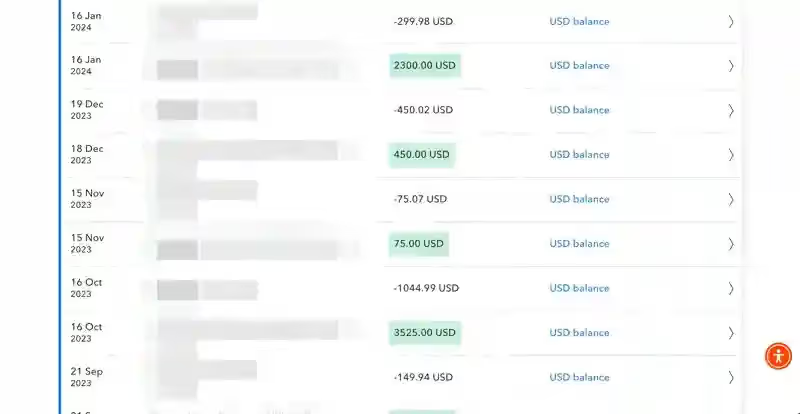
Payment Request from Clients
Using the payment system, you can send a payment request to your client.
The client will receive a notification via email and can make the payment with their card or from their account.

Receiving banking details
Some websites or clients may transfer money only using bank account details.
Payoneer allows you to obtain banking details for different currencies and countries.
- Swift (Wire) → USD.
- Europe → EUR.
- USA → USD.
- UK → GBP.
- Australia → AUD.
- UAE → AED.
- Japan → JPY.
Example:
Let's say you have a client from the USA who requests bank account details to pay for your services.
You obtain the banking details through Payoneer and provide them to the client. For the client, this payment will be as seamless as a domestic transaction.
This process is convenient, fast, and cost-effective.
The money transferred using these details will go into your Payoneer account. After the funds are credited, you can either transfer them to your account in a Ukrainian bank or order a Payoneer bank card. With the card, you can withdraw money from ATMs and make online payments.
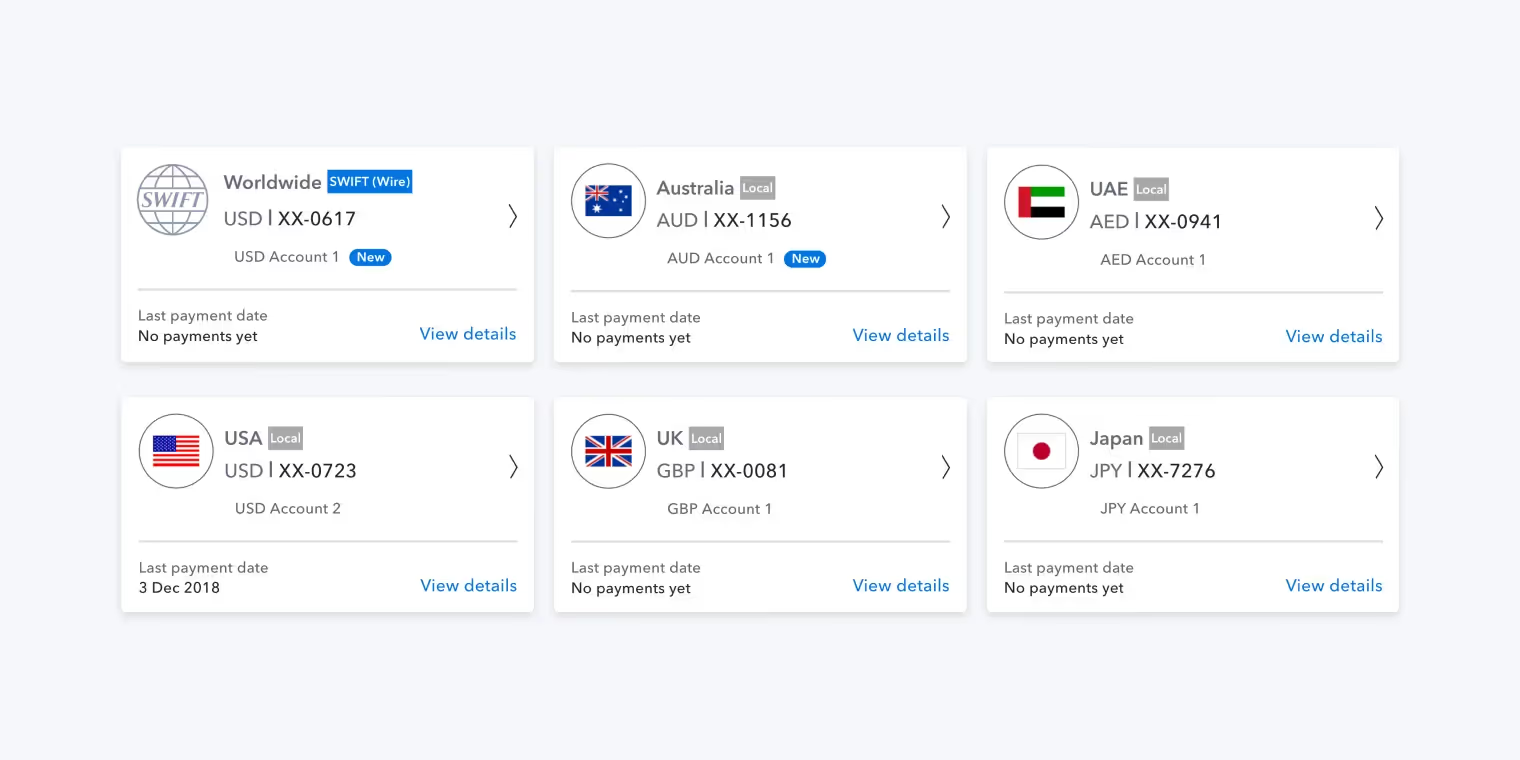
These are the three most popular ways to use the payment system:
- Receiving money from websites.
- Receiving money from clients.
- Receiving money through bank details.
Please note that Payoneer is exclusively designed for business transactions. You cannot send or receive money to and from friends and family using Payoneer. If you need to make transfers to acquaintances, consider using Wise or Skrill
What are Payoneer's fees and rates?
In short, the fees are low and competitive with Payoneer.
Payoneer offers three categories of services:
- Receiving money from websites and clients.
- Transferring money to other users.
- Withdrawing money to your bank account.
Let's break down each category separately.
What does the percentage depend on?
The same task can be accomplished in different ways.
For example:
You can generate an invoice for the client, and they can pay with a credit card directly on the Payoneer website. The commission for this payment will be 3%.
Alternatively, you provide the client with bank details, and they send the money independently through their bank, in which case the commission will be 1%.
The quicker and easier it is for the client, the higher the commission.
What are the fees for withdrawing money from Payoneer?
You can also order a virtual or plastic bank card from Payoneer. With the card, you can make online payments and withdraw money from ATMs.
Why might you need a Payoneer card?
- If you travel or prefer not to use your local bank account for transactions.
- If you frequently make online payments in the same currency as your Payoneer account.
What to consider if you decide to get the card?
If your funds are in dollars but you want to withdraw in a different currency from an ATM, there's a $3.15 transaction fee and up to 3.5% for conversion.
It's advisable to check your balance for free in the Payoneer app instead of paying $1 for an ATM balance inquiry.
Payoneer fees are lower than those of PayPal or Skrill. This information is taken from the official page.
Now that we've covered the fees.
How to create a Payoneer account?
Account registration is free, takes a few minutes, and consists of 4 steps:
- Getting started.
- Contact Details.
- Security Details.
- Almost Done.
Getting started
In the first step, you need to choose the account type, provide your name, email, and date of birth.
What types of accounts are there?
- Individual: If you will be receiving money as an individual.
- Company: If you have a registered company.
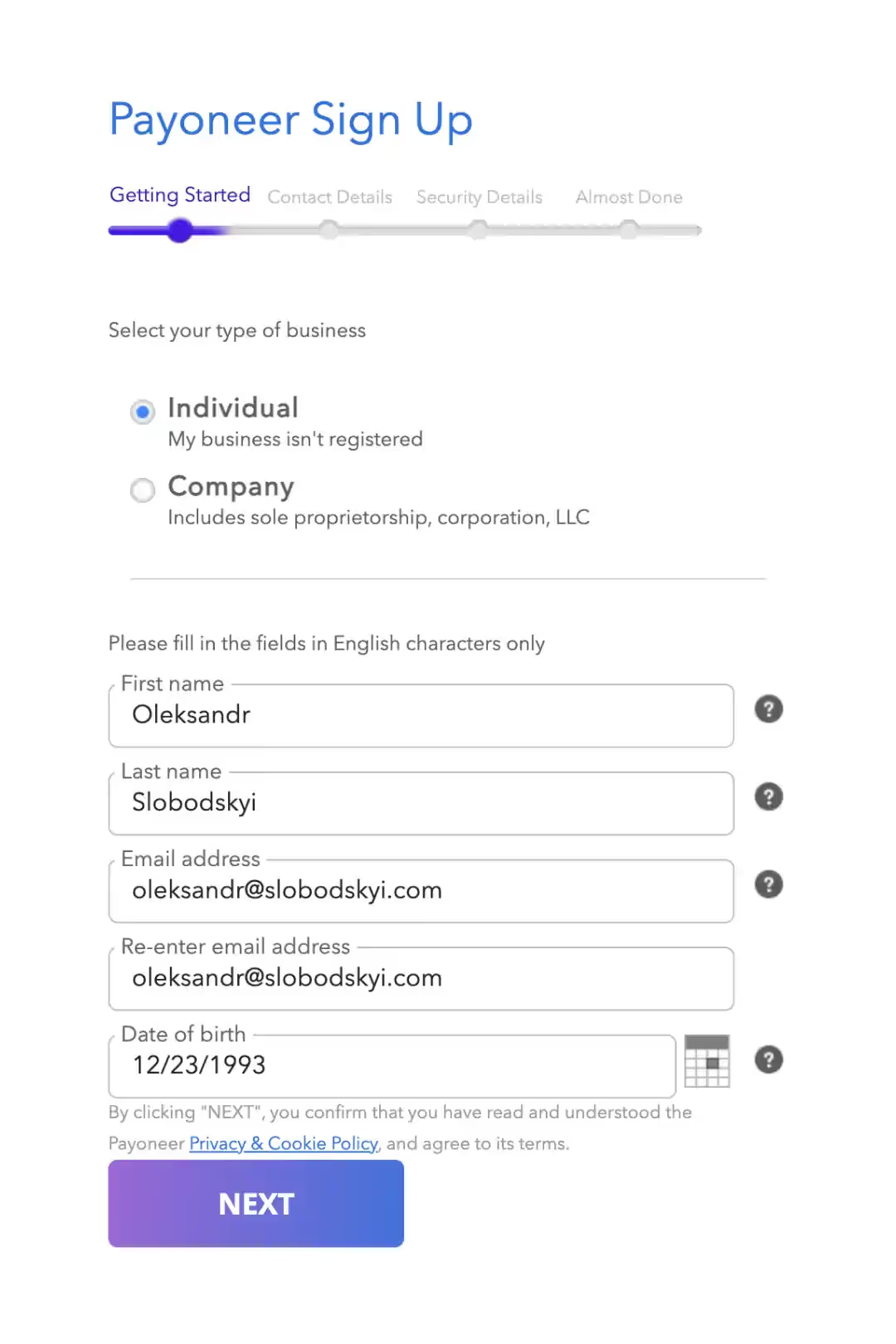
Contact Details
It's all straightforward.
Provide your registered address, postal code, and verify your phone number.

Security Details
Creating a password and a security question is the next step. In the ID details section, provide information about your documents.
Why is it necessary to provide document details?
This is a standard procedure for any payment system. The information is required to confirm your identity and for account recovery in case you forget your password. Payoneer is registered in the USA, and information about opening a Payoneer account and your accounts is not transmitted to your home country.
Which documents are acceptable?
- Passport (international).
- ID card.
- Driver's license.
- Tax Number.

Almost Done
Connecting a bank account.
For individuals, choose "Personal account," for companies, choose "Business account."
To link a bank account, you will need to provide its IBAN (International Bank Account Number).
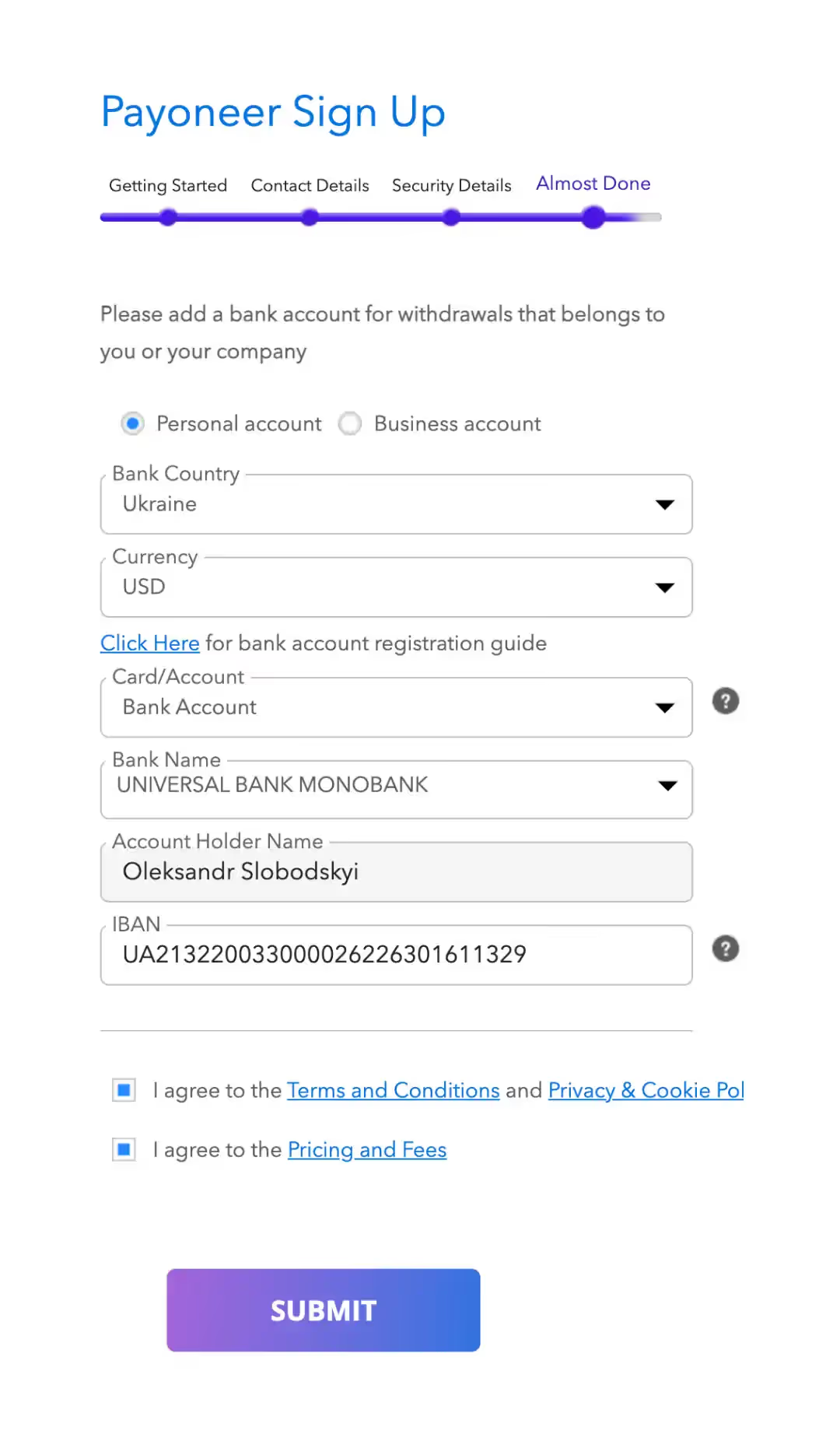
And that's it.
Click "Submit" and wait for your account to be activated.
While waiting, let's take a look at what the account looks like inside and how to receive and withdraw money.
How to receive and withdraw money with Payoneer?
After activating your account, here's what the home page will look like.
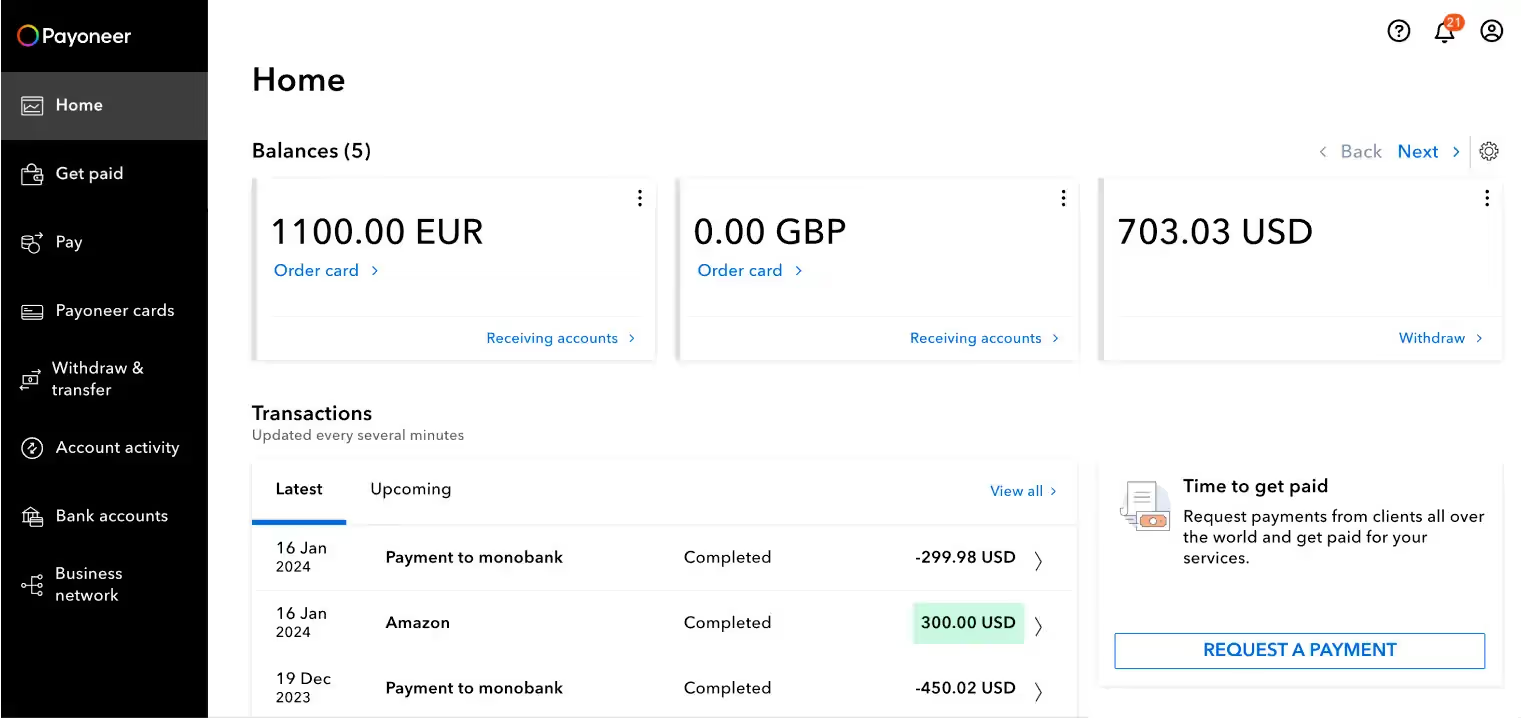
What do we have here?
- Home: Balances and recent transactions.
- Get Paid: Settings for receiving money.
- Pay: Payment for services.
- Payoneer cards: Management of bank cards.
- Withdraw & transfer: Withdrawal and fund transfer.
- Account activity: Statements and statistics.
- Bank accounts: Management of bank accounts.
- Business network: Management of sites from which money is received.
Navigation can be a bit confusing in some places, and you might end up in the same place from different sections.
Let's go through each section.
1. Home: Balances and recent transactions.
It's all straightforward here.
Balance of our accounts, notifications, and recent transactions.
2. Get Paid: Settings for receiving money.
In the "Get Paid" section, you have the following options:
- Request a payment: Send a payment request to a client.
- Batch payment request to multiple payers: Make multiple requests to different clients simultaneously.
- Receiving accounts: Obtain banking details in various currencies.
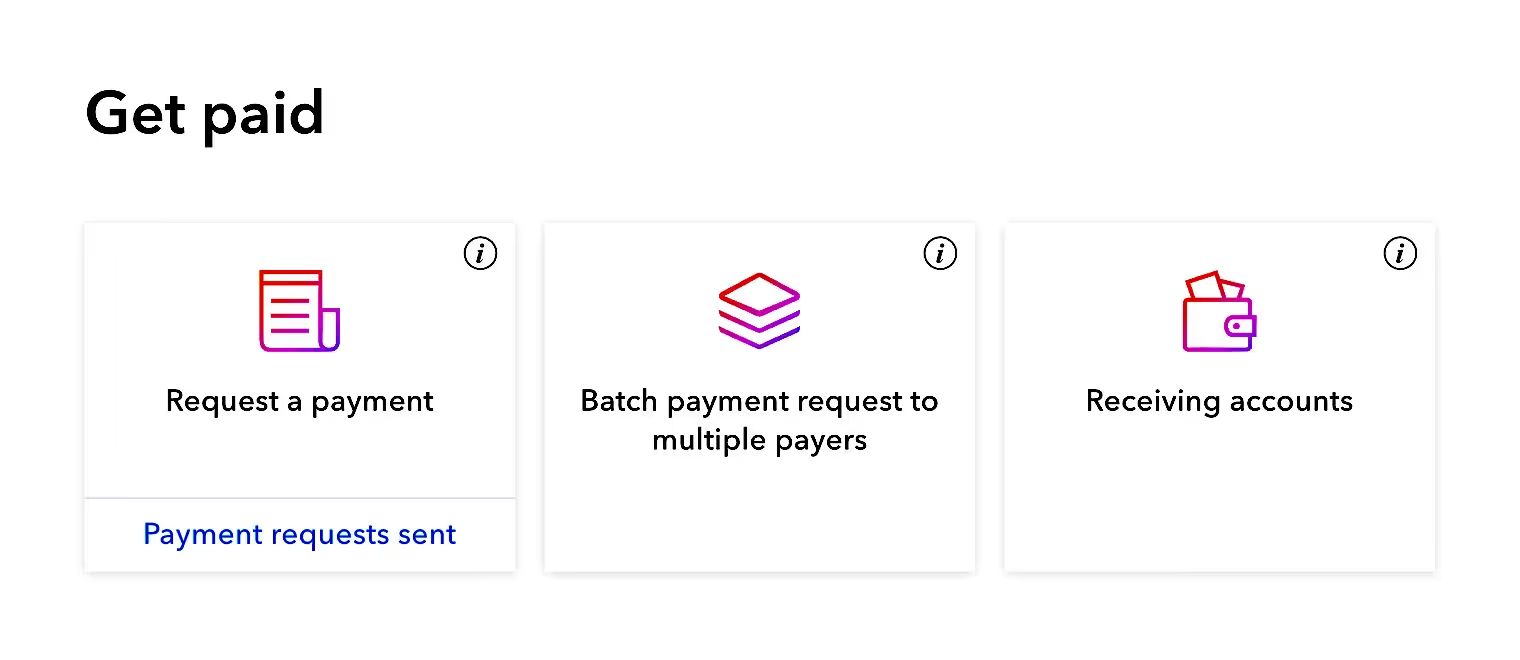
How to send a payment request to a client?
Click "Request a payment" and fill out the form.
- Provide the client's contact information.
- Specify the amount, currency, and service description. The request should be between $20 and $15,000.
- Set a deadline by which the client should complete the payment.
- Attach invoices and documents. You can create an invoice for free through freeinvoicebuilder.com. The invoice format is flexible; it should contain information about the services provided. If you are making a request for the first time, provide detailed information about what the money is specifically for. Requests undergo moderation.

After creating the request, the client will receive an email and can proceed with the payment.
Once the client completes the payment, the funds are credited to your account. Creating multiple invoices simultaneously works similarly.
Now, let's understand the last section in "Get Paid" called "Receiving accounts."
What are Receiving accounts?
As mentioned earlier, some websites or clients may request bank account details to send money. With Payoneer, you can obtain bank details in different countries. This service was previously known as the Global Payment Service.
For example, this way you can withdraw money from Gumroad.
Which currencies are available?
US Dollars, Euros, Japanese Yen, Emirati Dirhams, British Pounds, and Australian Dollars.

To obtain receiving details, click on "Request account," choose the account type, and select the currency.
- Local receiving account: If you need an account in the US, UK, Japan, UAE, or Australia. For clients, transfers through these details will be like local transfers within the country.
- SWIFT (Wire) receiving account: If you need an international account to receive money from marketplaces. You can view the list of marketplaces when creating the account.
Receiving and managing bank accounts are free; you only pay fees for transfers.

What will the banking details look like?
Example of an account in USD.
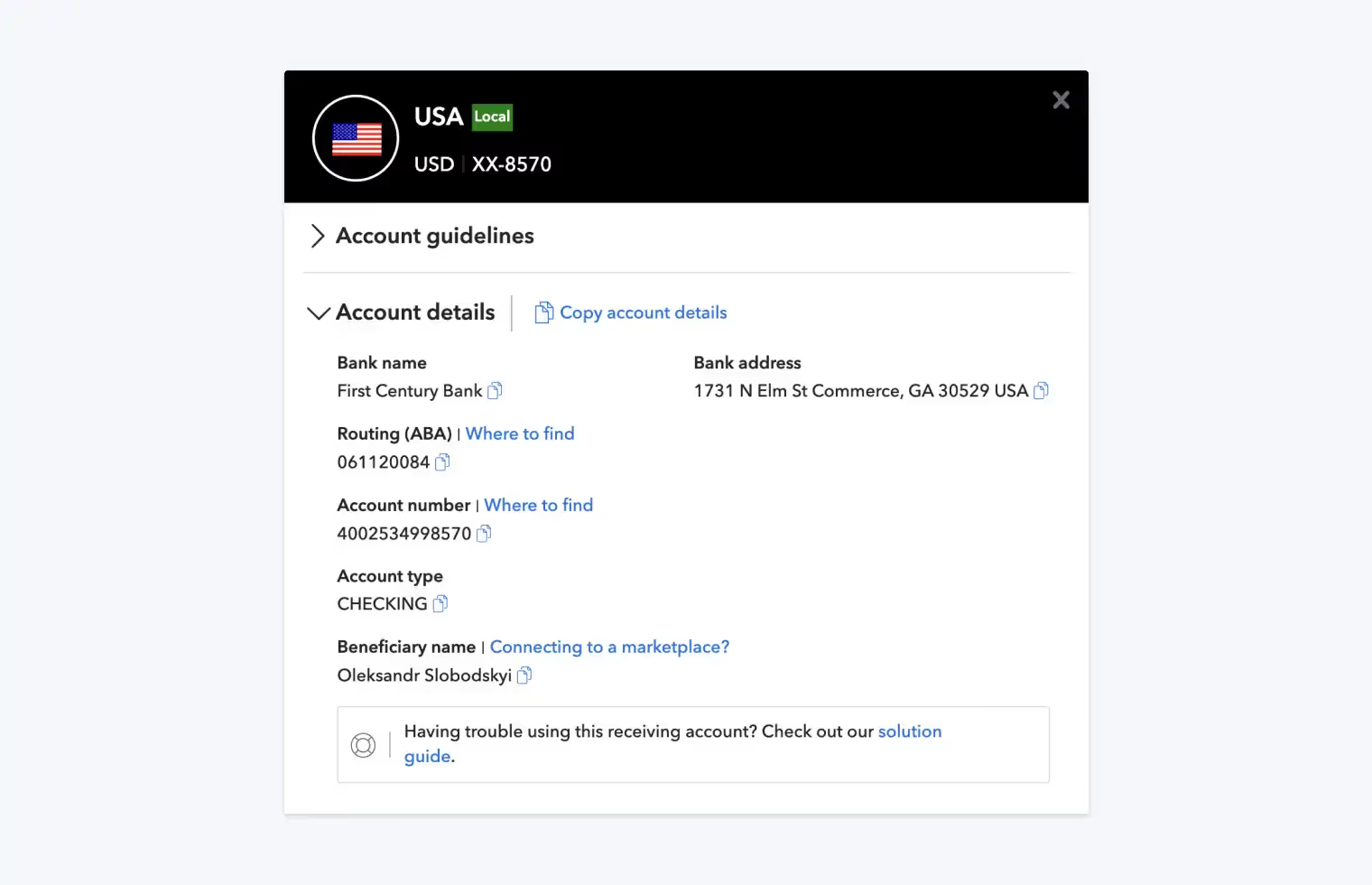
After a transfer using the provided details, the money is credited to your Payoneer account.
How to withdraw money from a website to Payoneer?
If the website supports integration with Payoneer, you simply need to specify your account's email in the settings.
Here's an example of how to set up withdrawals from Shutterstock.

If there is no direct integration with the website, use the bank details.
3. Pay: Payment for services.
If you need to send money, then you go to the "Pay" section.
You can send money to other Payoneer users by providing only their email. You can also make a transfer using bank details.

4. Payoneer cards: Management of bank cards.
Go to the "Payoneer cards" section and choose the type of card.
- Virtual: If you plan to use the card only online.
- Physical: If you need to withdraw money from ATMs.
These cards are issued in partnership with Mastercard.
Remember that the annual cost of maintaining a bank card is $29.95.

Why do you need a bank card?
- If you don't want to transfer money to a Ukrainian bank.
- If you travel a lot and withdraw money in local currency.
- If you want to connect the card to Binance, PayPal, or other services.
Here's what the card looks like.
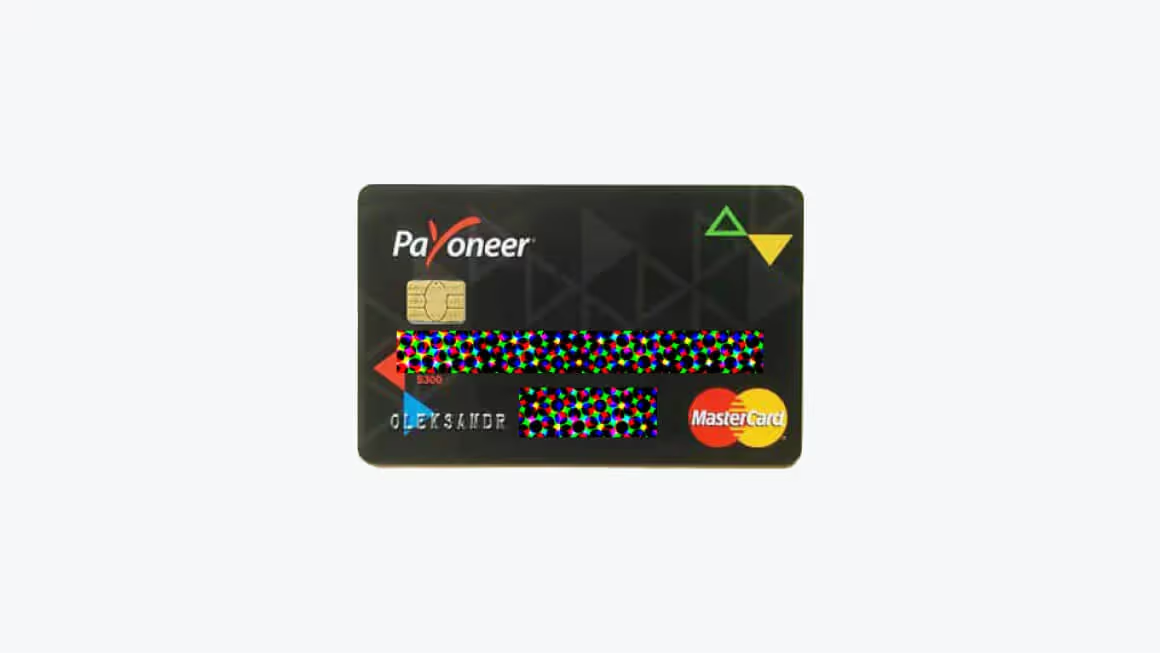
5. Withdraw & transfer.
We have two sections here.
- Withdraw to bank: This allows you to withdraw money to your local bank account. You can connect multiple accounts in different currencies.
- Convert currencies: This is for currency exchange from your Payoneer balance.
How to withdraw money from your Payoneer balance to a bank account:
- Click on "Withdraw to bank."
- Choose the account you want to withdraw to.
- Enter the amount.

What is the minimum withdrawal amount with Payoneer?
- In local currency: equivalent to $50.In dollars: $200.
- How long does it take?
Usually, money is credited within one day.
How to connect an additional bank account to Payoneer?
Click on "Manage bank accounts" → "Add account."
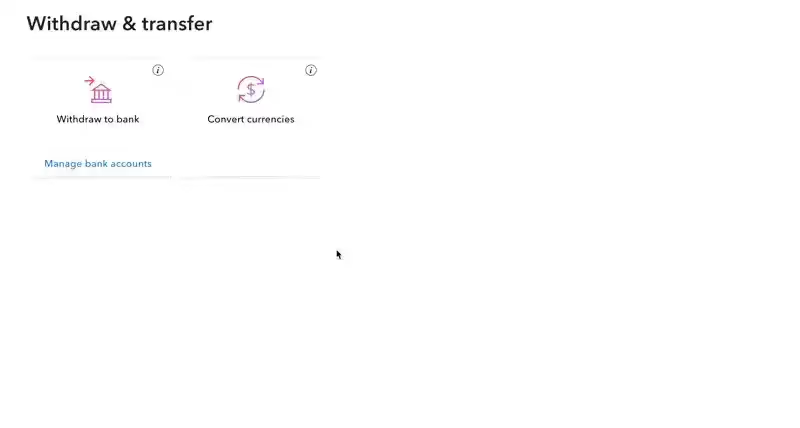
And you will be directed to a similar form as during registration.
Select the account type, country, and currency.
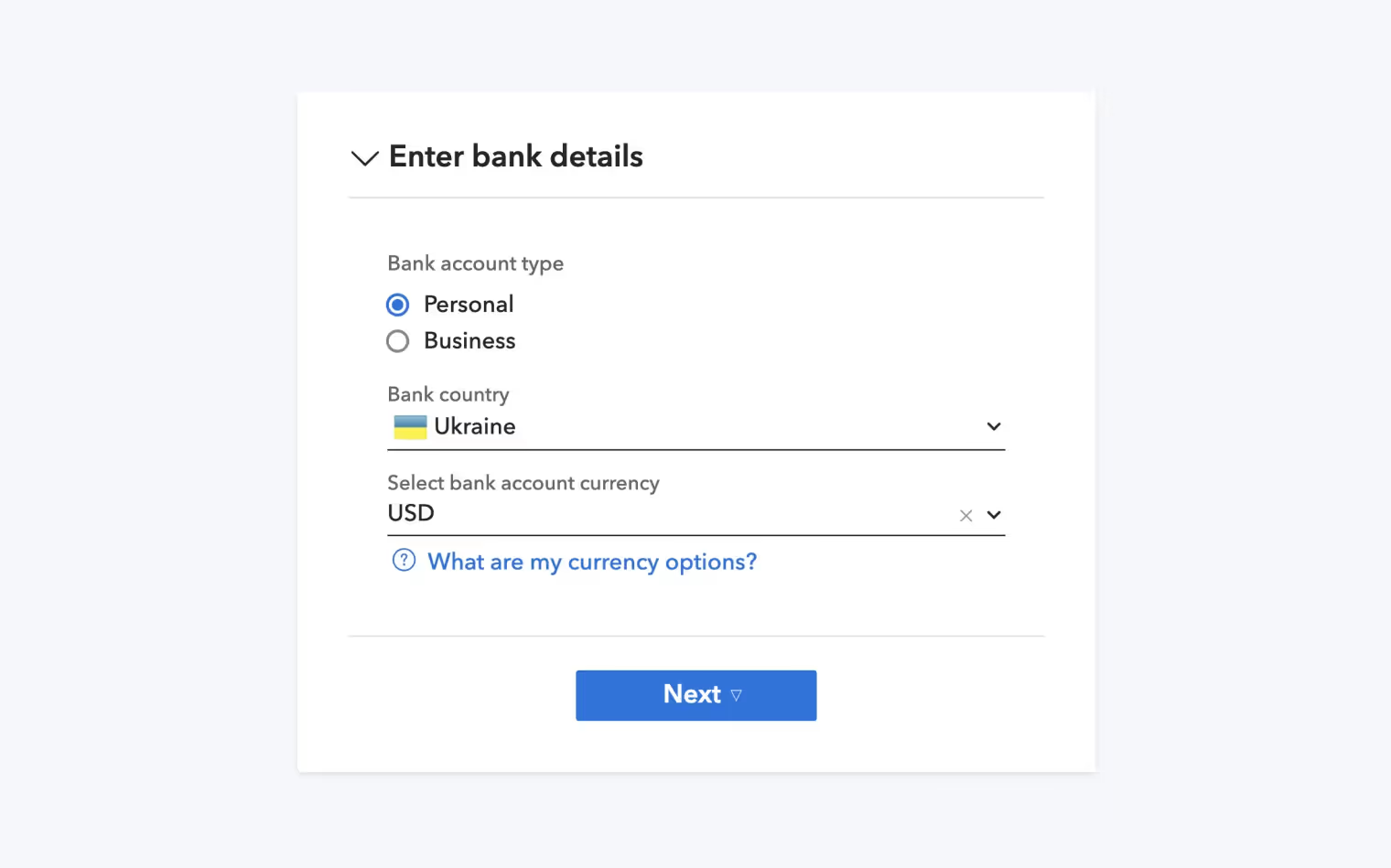
Select the bank from the list, provide the name, and enter the IBAN.

6. Account activity.
Here you can view the list of transactions and generate statements.
7. Bank accounts.
Here we have three sections:
- Bank accounts for withdrawal: A list of our connected bank accounts.
- Receiving accounts: A section for obtaining Payoneer's bank details in different currencies.
- Recipient bank accounts: A list of accounts to whom we've sent money.
Payoneer's navigation can be a bit confusing, and you might end up in the same place from different sections. For example, we connected bank accounts for withdrawal in the previous step, and you can access the section with details in different currencies (Receiving accounts) from the "2. Get Paid" section.

Поскольку с банковскими счетами и получением реквизитов мы уже разобрались, двигаемся дальше.
8. Business network.
In this section, we can view all the websites from which we withdraw money, as well as a list of clients.

My sites from which I withdrew money via Payoneer.
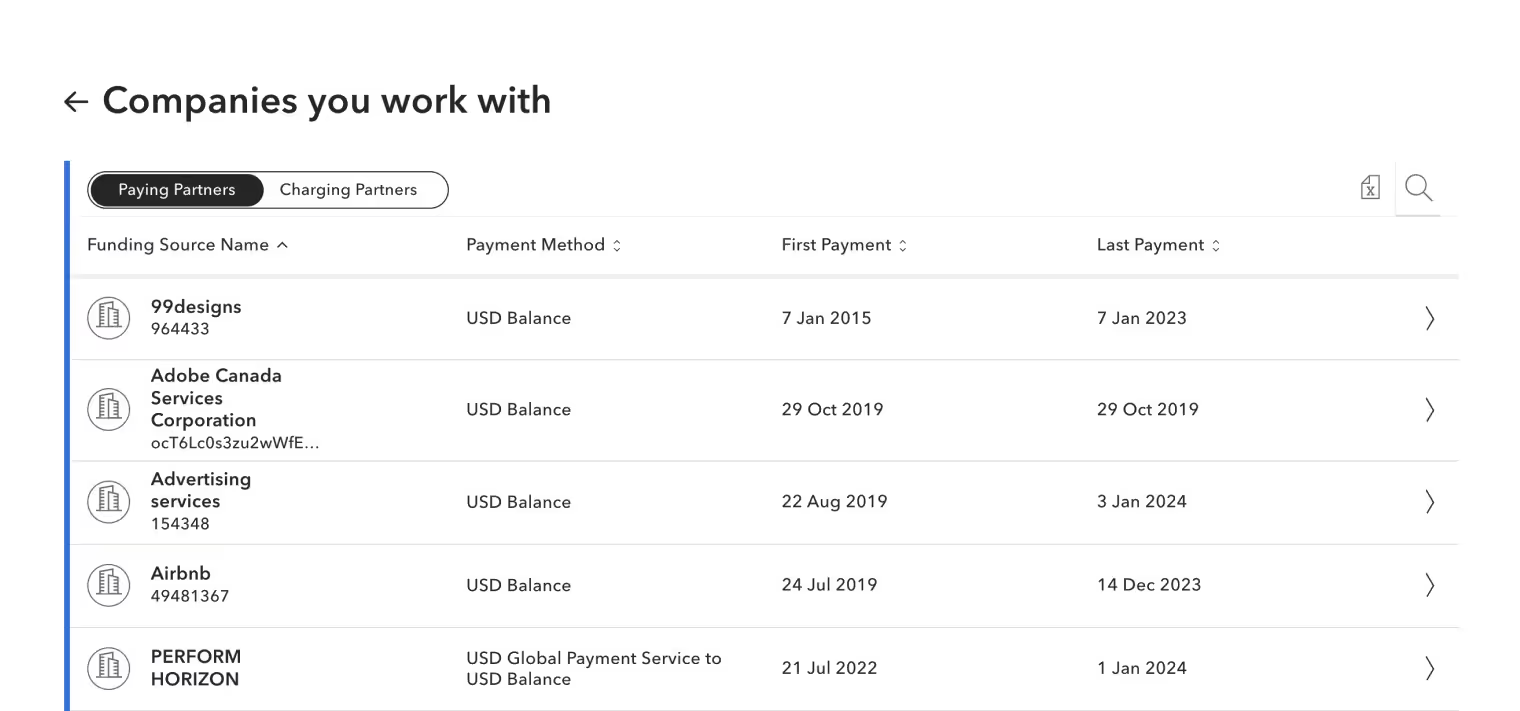
Summing up.
We've covered the following questions.
- What is the payment system Payoneer?
- What are the fees for transfers?
- How to create an account?
- How to receive and withdraw money?
Next, we'll delve into Payoneer reviews.
Reviews about Payoneer
I've been using the payment system for 10 years, and during this time, I've never had any issues. Money comes through, support responds, and all services work predictably.
While preparing this article, I studied reviews on the internet to understand the problems other users face. On Trustpilot, Payoneer has 50+ thousand reviews with a rating of 4/5.
This is a good result.
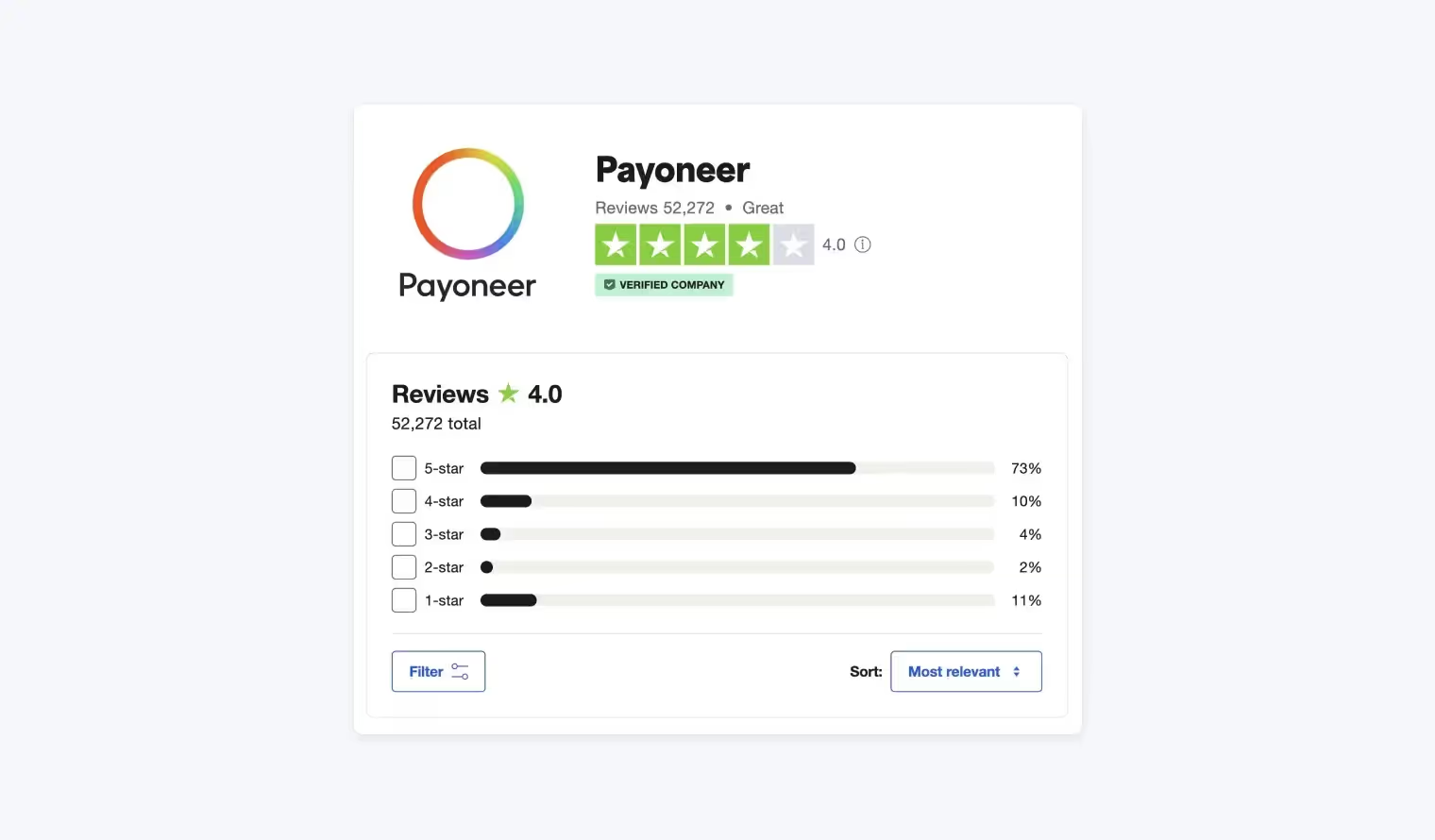
But what are people complaining about?
I've read 100+ negative reviews, and the main issues are as follows.
Not passing payments
As we mentioned before, Payoneer is used for business operations. You cannot transfer money to yourself or a friend. Payments that do not fall under business operations will be sent back. Many negative reviews are related to attempts to make personal transfers.
Use Skrill or Wise for transfers to relatives or friends.
Not clear on the fees
Due to the variety of services, it can be confusing at first. I recommend going through the Payoneer fee overview again.
There won't be any negative surprises, as you see the fee before making the payment.
A few negative reviews were related to dissatisfaction with the annual fee for Payoneer's bank card, which is $29.95. Order the card only if you really need it. Without the card, you only pay a percentage for transfers, and there is no account maintenance fee.
Support issues
Registered users can get support via email, online chat, and phone.
Users who do not yet have an account or are in the activation stage can only receive support via email.
How to contact support?
Visit the Payoneer Support Center and find the question that interests you. If the article's answer doesn't solve your problem, use the contact button at the bottom of the page.
If you couldn't find the question you need, use the contact form.
How to get phone support?
If you already have an account, you can call at +38-092-022-10-40 or +38-092-022-10-48. Phone support is available Monday through Friday from 09:00 to 18:00.
How to Choose: Payoneer, Skrill, Wise, or PayPal?
It all depends on what you need.
Looking to receive money from a website or a client?
Need to make a personal transfer to a friend or family member?
Opt for a different payment system:
I've got detailed reviews of these payment systems.
There's a step-by-step guide on how to use Wise for money transfers.
Some sites offer payouts through both Payoneer and Skrill, but Payoneer is often more cost-effective in terms of fees.
Skrill has its own advantages, such as the ability to work with cryptocurrencies. Registration is free for all these services, and there are no maintenance fees.
I recommend going through the reviews to find the option that best suits your task.
I have accounts with all these payment systems.
You never know when they might come in handy.
FAQ
How do I sign up for Payoneer?
To create a Payoneer account, visit their website and complete the four-step registration process: provide personal or business details, verify your identity, link your bank account, and wait for approval. The process is free and takes only a few minutes.
How can I log in to my Payoneer account?
Visit the Payoneer login page, enter your registered email and password, and complete any required two-step verification. Ensure you use the same credentials you provided during registration.
What are the main uses of Payoneer?
Payoneer allows users to receive payments from freelancing platforms, marketplaces, and clients worldwide. It also provides options to withdraw funds to local bank accounts or use a Payoneer card for online transactions and ATM withdrawals.
What fees does Payoneer charge?
Payoneer charges competitive fees, such as 2% for local bank withdrawals and $29.95 annually for card maintenance. Fees for receiving payments vary depending on the method, from free for Payoneer users to 3% for direct client payments.
Can I use Payoneer in Pakistan?
Yes, Payoneer operates in Pakistan, enabling users to receive payments from international platforms like Upwork, Fiverr, and Amazon. Funds can be transferred to Pakistani banks or accessed via a Payoneer card.
How does Payoneer compare to PayPal?
While both are popular for online payments, Payoneer focuses on international business transactions and offers features like global bank account details. PayPal, however, may have broader consumer use but is restricted in certain regions.
What is the minimum withdrawal amount for Payoneer?
The minimum withdrawal amount depends on the currency: $50 for local currency transfers and $200 for USD withdrawals. Processing typically takes one business day.
How can I contact Payoneer customer support?
Payoneer offers support through live chat, email, and phone. Existing users can log in for assistance, while new users can access email support. Support is available in multiple languages.
Can I link Payoneer to other services like PayPal or JazzCash?
Yes, you can link Payoneer to services like JazzCash for withdrawals. Linking Payoneer to PayPal is also possible in supported regions, enabling seamless fund transfers.
What are the benefits of a Payoneer card?
The Payoneer card allows users to withdraw funds from ATMs, make online payments, and transact in different currencies. It's especially useful for travelers and freelancers managing international clients.

On Patreon, I share my experiments, insights, and behind-the-scenes progress as I rebuild and grow. I explore fresh ideas across different media and languages, dive into AI tools, and pass along every lesson I learn.
 MonetizePayments
MonetizePayments







.svg)
